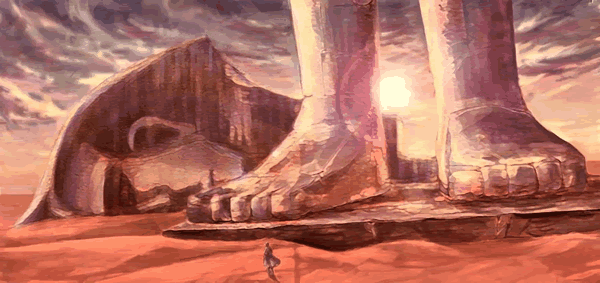

ragool
Ozymandias
The speaker of the poem meets a traveller who came from an ancient land. The traveller describes two large stone legs of a statue, which lack a torso to connect them and which stand upright in the desert. Near the legs, half-buried in sand, is the broken face of the statue. The statue's facial expression—a frown and a wrinkled lip—form a commanding, haughty sneer. The expression shows that the sculptor understood the emotions of the person the statue is based on, and now those emotions live on, carved forever on inanimate stone. In making the face, the sculptor’s skilled hands mocked up a perfect recreation of those feelings and of the heart that fed those feelings (and, in the process, so perfectly conveyed the subject’s cruelty that the statue itself seems to be mocking its subject). The traveller next describes the words inscribed on the pedestal of the statue, which say: "My name is Ozymandias, the King who rules over even other Kings. Behold what I have built, all you who think of yourselves as powerful, and despair at the magnificence and superiority of my accomplishments." There is nothing else in the area. Surrounding the remnants of the large statue is a never-ending and barren desert, with empty and flat sands stretching into the distance.
One of Shelley’s most famous works, “Ozymandias” describes the ruins of an ancient king’s statue in a foreign desert. All that remains of the statue are two “vast” stone legs standing upright and a head half-buried in sand, along with a boastful inscription describing the ruler as the “king of kings” whose mighty achievements invoke awe and despair in all who behold them. The inscription stands in contrast to the decrepit reality of the statue, however, underscoring the ultimate transience of political power. The poem implicitly critiques such power through its suggestion that both great rulers and their kingdoms will fall to the sands of time.
In the poem, the speaker relates a story a traveler told him about the ruins of a “colossal wreck” of a sculpture whose decaying physical state mirrors the dissolution of its subject’s—Ozymandias’s—power. Only two upright legs, a face, and a pedestal remain of Ozymandias’s original statue, and even these individual parts of the statue are not in great shape: the face, for instance, is “shattered." Clearly, time hasn’t been kind to this statue, whose pitiful state undercuts the bold assertion of its inscription. The fact that even this “king of kings” lies decaying in a distant desert suggests that no amount of power can withstand the merciless and unceasing passage of time.
The speaker goes on to explain that time not only destroyed this statue, it also essentially erased the entire kingdom the statue was built to overlook. The speaker immediately follows the king’s declaration found on the pedestal of the statue—“Look upon my works, ye Mighty, and despair!”—with the line “Nothing beside remains.” Such a savage contradiction makes the king’s prideful dare almost comically naïve.
Ozymandias had believed that while he himself would die, he would leave a lasting and intimidating legacy through everything he built. Yet his words are ultimately empty, as everything he built has crumbled. The people and places he ruled over are gone, leaving only an abandoned desert whose “lone and level sands” imply that there's not even a trace of the kingdom’s former glory to be found. The pedestal’s claim that onlookers should despair at Ozymandias’s works thus takes on a new and ironic meaning: one despairs not at Ozymandias’s power, but at how powerless time and decay make everyone.
The speaker also uses the specific example of Ozymandias to make a broader pronouncement about the ephemeral nature of power and, in turn, to implicitly critique tyranny. The speaker evokes the image of a cruel leader; Ozymandias wears a “frown” along with the “sneer of cold command." That such “passions” are now recorded only on “lifeless things” (i.e., the statue) is a clear rebuke of such a ruler, and suggests that the speaker believes such tyranny now only exists on the face of a dead and crumbling piece of stone.
The poem's depiction of the destruction of Ozymandias and his tyranny isn’t entirely fictional: Ozymandias is the Greek name for the Egyptian pharaoh Ramses II, who dramatically expanded Egypt’s empire and who had several statues of himself built throughout Egypt. In fact, the Ancient Greek writer Diodorus Siculus reported the following inscription on the base of one of Ozymandias’s statues: "King of Kings am I, Ozymandias. If anyone would know how great I am and where I lie, let him surpass one of my works." By alluding to an actual ancient empire, and an actual king, the poem reminds readers that history is full of the rises and falls of empires. No power is permanent, regardless of how omnipotent a ruler believes himself to be. Even the “king of kings” may one day be a forgotten relic of an “antique land.”
ragool
Web Developer.